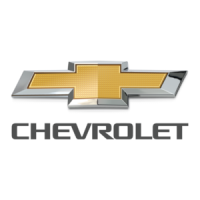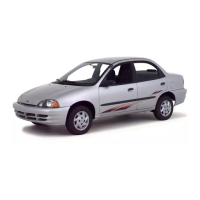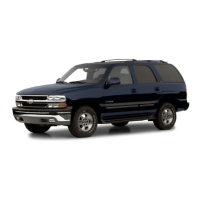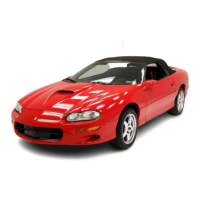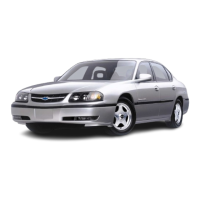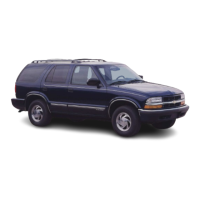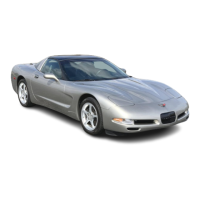Do you have a question about the Chevrolet 2000 Malibu and is the answer not in the manual?
Information on vehicle seats, safety belts, and proper usage for occupant protection.
Instructions on adjusting manual and power seats, including seatback and headrest adjustments.
Explains the importance and proper use of safety belts for all occupants, including children.
Information about the vehicle's air bag system, its function, and safety precautions.
Guidance on buckling up rear seat passengers and proper use of lap-shoulder belts.
Detailed information on child safety, including child restraints and proper placement.
How to use manual and power door locks, security locks, and anti-lockout features for vehicle access.
Procedures for starting the vehicle's engine, including flood conditions and battery protection.
How to operate the automatic transmission, including gear positions and shift lock controls.
How to set, increase, decrease, and end cruise control operation for maintaining speed.
Overview of instrument panel components, including gauges, indicators, and controls.
Explanation of the vehicle's instrument cluster, including warning lights and gauges.
Descriptions of various warning lights and gauges that alert the driver to vehicle conditions or problems.
Information about the safety belt reminder light and chime system for occupant safety.
Explanation of the air bag readiness light and what it indicates about the air bag system's status.
Information about the charging system indicator light and what it means for the vehicle's electrical system.
What the brake system warning light signifies and the actions to take if it illuminates.
Explanation of the ABS warning light and its implications for braking performance.
How to read the engine coolant temperature gauge and what an overheated engine indicates.
What the low coolant warning light indicates and the importance of checking coolant levels.
Information on the check engine light, its causes, and potential impact on emissions and performance.
What the oil pressure light means and the critical importance of addressing low oil pressure immediately.
How to interpret the check oil light and the steps to take to check and add engine oil.
Explanation of the Passlock warning light and what to do if the system enters tamper mode.
How to read the fuel gauge and understand low fuel warnings and normal gauge behavior.
How to operate the vehicle's ventilation and heating systems for occupant comfort.
Detailed explanation of climate control knobs (Fan, Temperature, Mode) and system functions.
How to use the DEFROST and DEFOG settings to clear front and side windows of fog and frost.
Operation of the radio, cassette player, SCV feature, and tone controls.
Operation of the radio, CD player, SCV feature, and tone controls for optimal audio experience.
Principles of defensive driving, emphasizing anticipation, awareness, and maintaining safe following distances.
The dangers of drinking and driving, its effects on performance, and legal limits for Blood Alcohol Concentration (BAC).
Explanation of the vehicle's control systems (brakes, steering, accelerator) and how tire-road friction affects control.
Details on perception and reaction time in braking, stopping distances, and factors affecting them.
How the ABS system works to prevent braking skids and the meaning of the ABS warning light.
Information on power steering, driving on curves, and steering techniques in emergency situations.
Tips for safely passing other vehicles on two-lane highways, including visibility and distance.
Understanding skidding and how to handle braking, steering, and acceleration skids.
Precautions and tips for safe night driving, including visibility, glare, and driver impairment.
How rain and wet roads affect traction and visibility, and precautions for driving in wet conditions.
Explanation of hydroplaning, its causes, and advice for avoiding it by slowing down in rain.
Advice for safe freeway driving, including merging, speed, lane usage, and lane changes.
Tips for safe winter driving, vehicle preparation, and emergency supplies.
How snow and ice affect traction, safe driving techniques, and the benefits of ABS on slippery roads.
Information on vehicle weight limits, load distribution, and cargo placement for safe handling.
Essential tips and safety rules for safely towing a trailer, including handling and equipment.
Important points to consider before trailering, including laws, sway control, and break-in periods.
Experience and tips for driving with a trailer, including checking equipment, handling, and electrical connections.
How to use hazard warning flashers to alert other drivers and indicate a vehicle problem.
Safe procedures for jump starting a vehicle with a dead battery using jumper cables.
Essential precautions and proper equipment usage to avoid injury and damage when towing a vehicle.
What to do if the engine overheats, including identifying steam, checking coolant, and potential fire hazards.
What to expect and do during a tire blowout or slow leak, including maintaining control and braking.
Step-by-step instructions for safely changing a flat tire using the vehicle's jack and tools.
Techniques for freeing a stuck vehicle, including the 'rocking' method and precautions against wheel spin.
How to check engine oil level, when to add oil, and the importance of using the correct type and viscosity.
Details on the DEX-COOL coolant system, its properties, and when to add coolant.
Information on brake fluid type (DOT-3) and location of the master cylinder reservoir.
How to identify worn brake pads through warning sounds and the importance of timely service.
Importance of properly maintained tires, dangers of overloading/underinflation, and when to replace worn tires.
How to check tire pressure, the meaning of 'cold' pressure, and the consequences of under/overinflation.
Details on maintenance services required and their recommended intervals based on driving conditions.
Definitions and intervals for Short Trip/City and Long Trip/Highway scheduled maintenance services.
How to check the engine oil level and add oil if necessary.
How to check the engine coolant level and add DEX-COOL if needed.
The importance of checking tire pressure regularly, including the spare tire.
How to inspect safety belts, air bags, and related components for proper function and wear.
Complete inspection of the brake system, including lines, pads, rotors, drums, and parking brake.
Details on the free roadside assistance program, services offered, and contact information.
Information on vehicle seats, safety belts, and proper usage for occupant protection.
Instructions on adjusting manual and power seats, including seatback and headrest adjustments.
Explains the importance and proper use of safety belts for all occupants, including children.
Information about the vehicle's air bag system, its function, and safety precautions.
Guidance on buckling up rear seat passengers and proper use of lap-shoulder belts.
Detailed information on child safety, including child restraints and proper placement.
How to use manual and power door locks, security locks, and anti-lockout features for vehicle access.
Procedures for starting the vehicle's engine, including flood conditions and battery protection.
How to operate the automatic transmission, including gear positions and shift lock controls.
How to set, increase, decrease, and end cruise control operation for maintaining speed.
Overview of instrument panel components, including gauges, indicators, and controls.
Explanation of the vehicle's instrument cluster, including warning lights and gauges.
Descriptions of various warning lights and gauges that alert the driver to vehicle conditions or problems.
Information about the safety belt reminder light and chime system for occupant safety.
Explanation of the air bag readiness light and what it indicates about the air bag system's status.
Information about the charging system indicator light and what it means for the vehicle's electrical system.
What the brake system warning light signifies and the actions to take if it illuminates.
Explanation of the ABS warning light and its implications for braking performance.
How to read the engine coolant temperature gauge and what an overheated engine indicates.
What the low coolant warning light indicates and the importance of checking coolant levels.
Information on the check engine light, its causes, and potential impact on emissions and performance.
What the oil pressure light means and the critical importance of addressing low oil pressure immediately.
How to interpret the check oil light and the steps to take to check and add engine oil.
Explanation of the Passlock warning light and what to do if the system enters tamper mode.
How to read the fuel gauge and understand low fuel warnings and normal gauge behavior.
How to operate the vehicle's ventilation and heating systems for occupant comfort.
Detailed explanation of climate control knobs (Fan, Temperature, Mode) and system functions.
How to use the DEFROST and DEFOG settings to clear front and side windows of fog and frost.
Operation of the radio, cassette player, SCV feature, and tone controls.
Operation of the radio, CD player, SCV feature, and tone controls for optimal audio experience.
Principles of defensive driving, emphasizing anticipation, awareness, and maintaining safe following distances.
The dangers of drinking and driving, its effects on performance, and legal limits for Blood Alcohol Concentration (BAC).
Explanation of the vehicle's control systems (brakes, steering, accelerator) and how tire-road friction affects control.
Details on perception and reaction time in braking, stopping distances, and factors affecting them.
How the ABS system works to prevent braking skids and the meaning of the ABS warning light.
Information on power steering, driving on curves, and steering techniques in emergency situations.
Tips for safely passing other vehicles on two-lane highways, including visibility and distance.
Understanding skidding and how to handle braking, steering, and acceleration skids.
Precautions and tips for safe night driving, including visibility, glare, and driver impairment.
How rain and wet roads affect traction and visibility, and precautions for driving in wet conditions.
Explanation of hydroplaning, its causes, and advice for avoiding it by slowing down in rain.
Advice for safe freeway driving, including merging, speed, lane usage, and lane changes.
Tips for safe winter driving, vehicle preparation, and emergency supplies.
How snow and ice affect traction, safe driving techniques, and the benefits of ABS on slippery roads.
Information on vehicle weight limits, load distribution, and cargo placement for safe handling.
Essential tips and safety rules for safely towing a trailer, including handling and equipment.
Important points to consider before trailering, including laws, sway control, and break-in periods.
Experience and tips for driving with a trailer, including checking equipment, handling, and electrical connections.
How to use hazard warning flashers to alert other drivers and indicate a vehicle problem.
Safe procedures for jump starting a vehicle with a dead battery using jumper cables.
Essential precautions and proper equipment usage to avoid injury and damage when towing a vehicle.
What to do if the engine overheats, including identifying steam, checking coolant, and potential fire hazards.
What to expect and do during a tire blowout or slow leak, including maintaining control and braking.
Step-by-step instructions for safely changing a flat tire using the vehicle's jack and tools.
Techniques for freeing a stuck vehicle, including the 'rocking' method and precautions against wheel spin.
How to check engine oil level, when to add oil, and the importance of using the correct type and viscosity.
Details on the DEX-COOL coolant system, its properties, and when to add coolant.
Information on brake fluid type (DOT-3) and location of the master cylinder reservoir.
How to identify worn brake pads through warning sounds and the importance of timely service.
Importance of properly maintained tires, dangers of overloading/underinflation, and when to replace worn tires.
How to check tire pressure, the meaning of 'cold' pressure, and the consequences of under/overinflation.
Details on maintenance services required and their recommended intervals based on driving conditions.
Definitions and intervals for Short Trip/City and Long Trip/Highway scheduled maintenance services.
How to check the engine oil level and add oil if necessary.
How to check the engine coolant level and add DEX-COOL if needed.
The importance of checking tire pressure regularly, including the spare tire.
How to inspect safety belts, air bags, and related components for proper function and wear.
Complete inspection of the brake system, including lines, pads, rotors, drums, and parking brake.
Details on the free roadside assistance program, services offered, and contact information.
| Brand | Chevrolet |
|---|---|
| Model | 2000 Malibu |
| Category | Automobile |
| Language | English |
